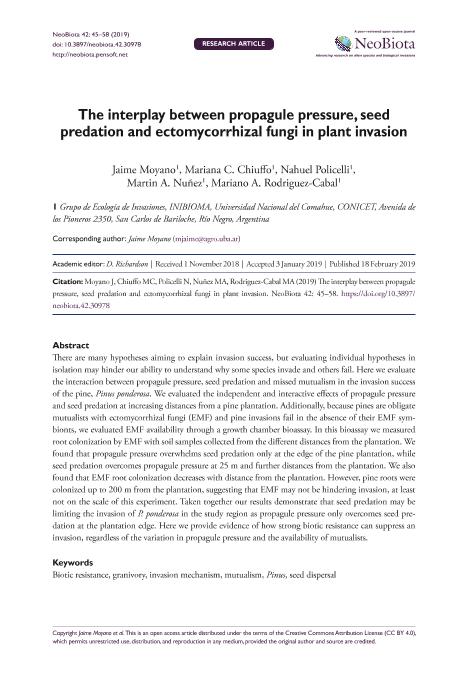Artículo
The interplay between propagule pressure, seed predation and ectomycorrhizal fungi in plant invasion
Moyano, Jaime ; Chiuffo, Mariana Cecilia
; Chiuffo, Mariana Cecilia ; Policelli, Nahuel
; Policelli, Nahuel ; Nuñez, Martin Andres
; Nuñez, Martin Andres ; Rodriguez Cabal, Mariano Alberto
; Rodriguez Cabal, Mariano Alberto
 ; Chiuffo, Mariana Cecilia
; Chiuffo, Mariana Cecilia ; Policelli, Nahuel
; Policelli, Nahuel ; Nuñez, Martin Andres
; Nuñez, Martin Andres ; Rodriguez Cabal, Mariano Alberto
; Rodriguez Cabal, Mariano Alberto
Fecha de publicación:
02/2019
Editorial:
Pensoft Publishers
Revista:
NeoBiota
ISSN:
1619-0033
Idioma:
Inglés
Tipo de recurso:
Artículo publicado
Clasificación temática:
Resumen
There are many hypotheses aiming to explain invasion success, but evaluating individual hypotheses in isolation may hinder our ability to understand why some species invade and others fail. Here we evaluate the interaction between propagule pressure, seed predation and missed mutualism in the invasion success of the pine, Pinus ponderosa. We evaluated the independent and interactive effects of propagule pressure and seed predation at increasing distances from a pine plantation. Additionally, because pines are obligate mutualists with ectomycorrhizal fungi (EMF) and pine invasions fail in the absence of their EMF symbionts, we evaluated EMF availability through a growth chamber bioassay. In this bioassay we measured root colonization by EMF with soil samples collected from the different distances from the plantation. We found that propagule pressure overwhelms seed predation only at the edge of the pine plantation, while seed predation overcomes propagule pressure at 25 m and further distances from the plantation. We also found that EMF root colonization decreases with distance from the plantation. However, pine roots were colonized up to 200 m from the plantation, suggesting that EMF may not be hindering invasion, at least not on the scale of this experiment. Taken together our results demonstrate that seed predation may be limiting the invasion of P. ponderosa in the study region as propagule pressure only overcomes seed predation at the plantation edge. Here we provide evidence of how strong biotic resistance can suppress an invasion, regardless of the variation in propagule pressure and the availability of mutualists.
Palabras clave:
BIOTIC RESISTANCE
,
GRANIVORY
,
INVASION MECHANISM
,
MUTUALISM
,
PINUS
,
SEED DISPERSAL
Archivos asociados
Licencia
Identificadores
Colecciones
Articulos(INIBIOMA)
Articulos de INST. DE INVEST.EN BIODIVERSIDAD Y MEDIOAMBIENTE
Articulos de INST. DE INVEST.EN BIODIVERSIDAD Y MEDIOAMBIENTE
Citación
Moyano, Jaime; Chiuffo, Mariana Cecilia; Policelli, Nahuel; Nuñez, Martin Andres; Rodriguez Cabal, Mariano Alberto; The interplay between propagule pressure, seed predation and ectomycorrhizal fungi in plant invasion; Pensoft Publishers; NeoBiota; 42; 2-2019; 45-58
Compartir



